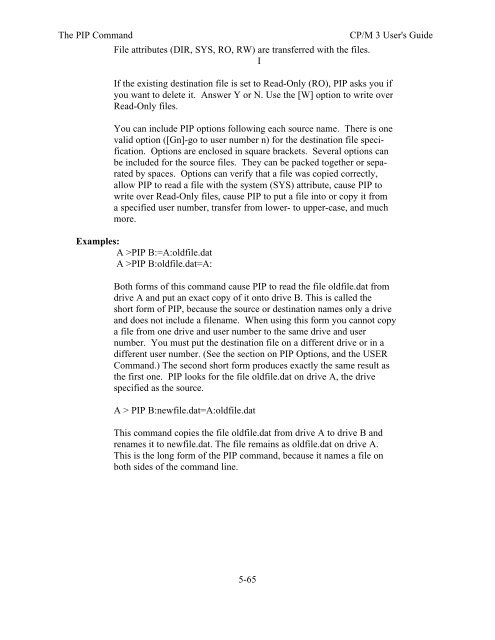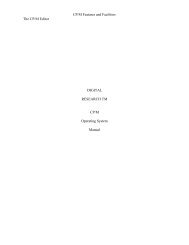DIGITAL RESEARCH(r) CP/M Plus TM (CP/M Version 3) Operating ...
DIGITAL RESEARCH(r) CP/M Plus TM (CP/M Version 3) Operating ...
DIGITAL RESEARCH(r) CP/M Plus TM (CP/M Version 3) Operating ...
Create successful ePaper yourself
Turn your PDF publications into a flip-book with our unique Google optimized e-Paper software.
The PIP Command <strong>CP</strong>/M 3 User's Guide<br />
File attributes (DIR, SYS, RO, RW) are transferred with the files.<br />
I<br />
If the existing destination file is set to Read-Only (RO), PIP asks you if<br />
you want to delete it. Answer Y or N. Use the [W] option to write over<br />
Read-Only files.<br />
You can include PIP options following each source name. There is one<br />
valid option ([Gn]-go to user number n) for the destination file specification.<br />
Options are enclosed in square brackets. Several options can<br />
be included for the source files. They can be packed together or separated<br />
by spaces. Options can verify that a file was copied correctly,<br />
allow PIP to read a file with the system (SYS) attribute, cause PIP to<br />
write over Read-Only files, cause PIP to put a file into or copy it from<br />
a specified user number, transfer from lower- to upper-case, and much<br />
more.<br />
Examples:<br />
A >PIP B:=A:oldfile.dat<br />
A >PIP B:oldfile.dat=A:<br />
Both forms of this command cause PIP to read the file oldfile.dat from<br />
drive A and put an exact copy of it onto drive B. This is called the<br />
short form of PIP, because the source or destination names only a drive<br />
and does not include a filename. When using this form you cannot copy<br />
a file from one drive and user number to the same drive and user<br />
number. You must put the destination file on a different drive or in a<br />
different user number. (See the section on PIP Options, and the USER<br />
Command.) The second short form produces exactly the same result as<br />
the first one. PIP looks for the file oldfile.dat on drive A, the drive<br />
specified as the source.<br />
A > PIP B:newfile.dat=A:oldfile.dat<br />
This command copies the file oldfile.dat from drive A to drive B and<br />
renames it to newfile.dat. The file remains as oldfile.dat on drive A.<br />
This is the long form of the PIP command, because it names a file on<br />
both sides of the command line.<br />
5-65




